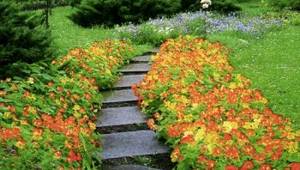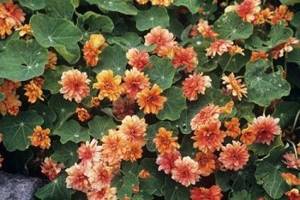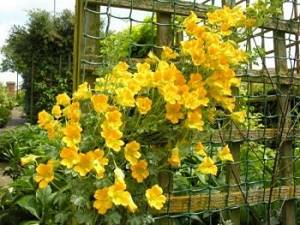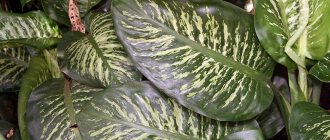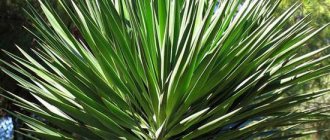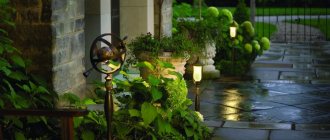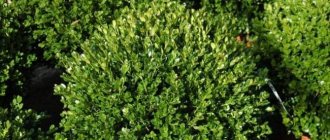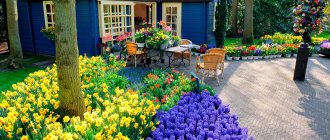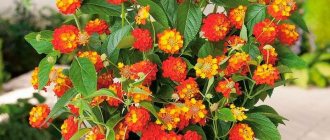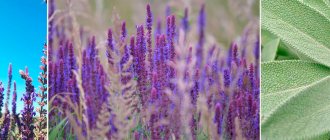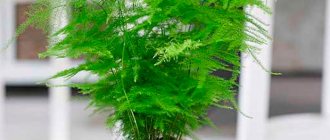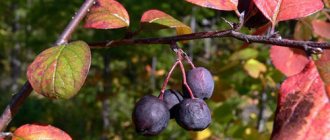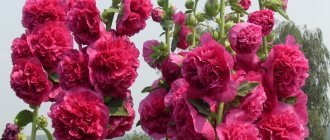What does a climbing nasturtium flower look like?
Nasturtium in the garden
Nasturtium is a flower that begins to bloom in early summer. There are a large number of plant varieties. But climbing nasturtium has common characteristics that distinguish the culture from other varieties.
Which family does it belong to?
Nasturtium flowers belong to the Capuchinaceae (Nasturtium) family. It can be a perennial or annual species depending on the variety. There are more than 80 plant varieties.
Briefly about the history of appearance

Bright flowers look great in any flower bed
The plant was first noticed in South America. Later, varieties of the crop spread to Central America. Gradually, the unusual flower became widespread in various countries, where it was called capuchin.
For reference! The seedling was brought to Russia from Holland. Due to its high ability to take root in any conditions, the plant has become popular.
Plant characteristics
Has the following characteristics:
- the vine forms side shoots, which leads to the weaving of large areas;
- suitable for landscaping gazebos, balconies and fences;
- the roots are located in the top layer of soil;
- buds are large yellow or orange;
- leaves are heart-shaped or small round.
The length of the vine can reach up to 4 meters with proper care. The crop can be grown using seeds or seedlings.
Useful properties of nasturtium
Nasturtium in a flowerbed can act not only as a decoration. The plant has a large number of beneficial properties.
The most famous include:
- bactericidal properties;
- vasodilation;
- anti-inflammatory properties (can be used to remove purulent formations);
- for the treatment of cough;
- treatment of skin for fungal diseases;
- restoration of the heart muscle;
- relief of menopause symptoms in women.
The plant has also gained great popularity in cosmetology. Using the plant extract, you can rejuvenate the skin and improve the condition of the hair.
Important! Nasturtium is not used for diseases of the digestive system.
Also, if the juice of the culture gets on the mucous membranes of the eyes, inflammation may occur.
Features of cultivation: planting nasturtium in open ground
By following simple rules, you can successfully grow nasturtium in the garden, enjoying its fragrant flowers until autumn.
1. To grow a plant you need to choose a suitable place.
Nasturtium comes from South America, so it loves warmth and sun. The landing site should be well lit throughout the day. A plant planted in the shade will not bloom. You should also protect the delicate flower from wind and drafts.
2. Nasturtium prefers light, moderately nutritious soils.
Soil overfed with organic matter is not the best option for growing plants. On too “fat” lands the bushes bloom sparsely. But poor soils also have a bad effect on the condition of the annual plant: the stems become bare, the leaves become smaller. Experienced gardeners regularly add mineral complexes, which nasturtium loves very much. As a result, the flowers become large, the leaves become shiny, and buds form until October.
3. It is better to grow nasturtium using the seedless method, sowing the seeds directly into the ground.
The fragile root system of the plant cannot tolerate transplantation, it is often injured and the flower dies.
You need to sow the seeds with the onset of warm weather, somewhere in early May. The sowing bed is pre-watered with warm water, which promotes rapid seed germination and early flowering. The seeding depth is about 2 cm, the distance between plants should be at least 25 cm. Plants grown in this way are stronger and healthier, which prolongs flowering time. If the threat of frost has not yet passed, then the planting dates need to be postponed or the seedlings should be protected from the cold.
Important! If there is a need to grow nasturtium through seedlings, then only peat cups are used for planting. Transplanting such plants does not damage the roots, since there is no need to remove the seedling from the pot.
Classification of popular types of nasturtiums
Types of ferns and their classification
Varieties of nasturtium have distinctive characteristics and are often used to create unique landscape compositions.
- Nasturtium foreign, or Canarian
A distinctive feature of the culture is the length of the vine, which can reach up to 4 meters. The liana is fleshy with a large number of side shoots.
Climbing nasturtium is used to decorate gazebos and slides. The leaves have a bright green color. A special feature of the plant is its small yellow buds.

Foreign nasturtium
- Large nasturtium
Large nasturtium is distinguished by its large size. Forms a bush that can reach a height of up to 1 meter.
The shoots are fleshy, but weak. The leaves are large green. Large buds can be terry or regular.
- Nasturtium cultivated
A hybrid plant, bushes can reach up to 50 cm in height. The leaves are round and large. Varieties of this variety can be compact in size or used for landscaping gazebos. The shoots are strong, densely decorated with leaves.
- Small nasturtium
Nasturtium minor is a small plant that is often found in gardens. The bush can reach up to 30 cm in height.
The leaves are small, heart-shaped. The buds are small yellow with small dark spots. The flowering period is from early summer until the first frost.
- Nasturtium shieldbearing
A shrub that has long shoots (up to 4 meters). The leaves are densely spaced and dark green in color. The buds are small and red.
Under natural conditions, nasturtium is a perennial plant. However, in many regions of Russia it cannot withstand frost. Therefore, the plant is regularly planted in the spring by using seeds or seedlings.
Important! The varieties of culture described above require undemanding care; they are immune to various types of diseases.
All the advantages of tender nasturtium
In addition to the amazing ability to transform the most dull corners of the garden into a picturesque picture, nasturtium has other advantages. She can protect garden crops from pests by sacrificing herself to them. And its leaves, flowers and fruits, which have healing properties, are used in cooking to add piquancy and spiciness to dishes.
Types and varieties of nasturtium
The leaves of this ornamental plant are predominantly round in shape and large. And the flowers can be simple or double, with an unusual irregular shape. The fruits with seeds are also quite large, so planting them is easy.
Among the many species there are climbing vines, subshrubs, and dwarf low-growing plants:
| Types of nasturtium | Description |
| Bush species hold their shape well, so they are most often used for creating borders and edging paths. |
| Low-growing plants up to 30 cm high can also serve as a border for a flower garden. But they look especially good in flowerpots and flowerpots, decorating both the garden and the city balcony. |
| The stems of climbing nasturtium reach several meters in length. Depending on the planting location, they create a creeping flowering carpet on the ground, or weave around arches, pergolas, walls of houses and gazebos. They can also be used as hanging plants - for planting in hanging baskets. |
| Terry hybrids are most often vines that look best in an hanging, hanging form. |
| A special species is Canarian nasturtium. Its leaves are not round, but palmate, and the flowers are always yellow. This is a vine that can cover a gazebo or an unsightly fence in a short time. |
Regular nasturtium is usually yellow or red in color. But every year new hybrid varieties of various shapes and shades appear. Among them are white, pink, dark cherry.
Here are just a few examples:

Alaska - a colorful mixture of natural shades
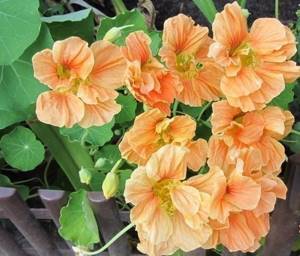
Vesuvius bush

Yeti
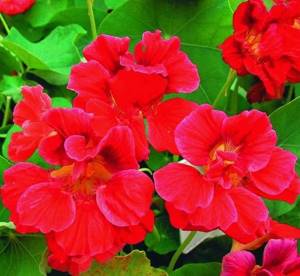
Cherry rose - double type
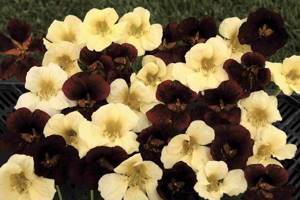
Day and night - flowers of contrasting colors

Canary - liana
By selecting nasturtiums by type and color, you can create bright waterfalls, beautiful borders, and colorful carpets in your garden. It grows well in poor soils, without requiring fertilizing or frequent watering. The only thing she needs is warmth and sunlight.
Nasturtium in cooking
The taste of nasturtium is quite pleasant, so all parts of the plant, except the roots, are used in cooking:
- Flowers and leaves can be a wonderful decoration for dishes. They are added to sandwiches, salads, and cold soups.
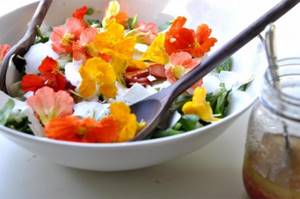
Nasturtium, basil and cheese salad
- Dried and crushed seeds are used as a seasoning, similar to black pepper.
- Pickled fruits that have not reached maturity are also eaten.
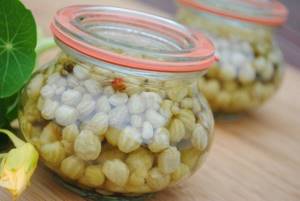
Pickled capers
Note. The plant has healing properties that can help in the treatment of anemia, vitamin deficiency, skin and kidney diseases. Its leaves and flowers contain a lot of vitamins A and C.
Nasturtium in the garden
Unlike marigolds and calendula, nasturtium does not repel insect pests, but attracts them. Its juicy stems and leaves are a real delicacy for them, which they will prefer to any other crops.

Planting nasturtiums between the beds will decorate the garden and protect vegetables from aphids
Of course, the plant itself may suffer from the insatiable appetite of aphids and other pests, but cabbage, zucchini, cucumbers, tomatoes, radishes or strawberries will remain intact.
Varieties that are most popular with gardeners
Indian chrysanthemum - characteristics of varieties and cultivation from a mixture of seeds
Among the wide variety of plant varieties, it is necessary to highlight the most popular among gardeners.
- Alaska
Nasturtium Alaska is distinguished by a wide variety of bud colors. The height of the bush can reach up to 40 cm. The shoots are well developed with a large number of lateral branches.

Alaska variety
- Maiden Beauty
Nasturtium Maiden's Beauty is distinguished by a variety of colors. The buds are small in size, located on small side shoots.
- Canary
An annual climbing plant, the length of the vines can reach up to 3 meters. Small inflorescences are located on the side shoots.
Blooms bright yellow throughout the summer.
- Vesuvius
The plant grows to a height of no more than 26 cm. The stems are strong, erect, with a large number of lateral branches. The buds are orange in color with burgundy splashes.
Important! In order for the bush to maintain its compact size, it is necessary to timely tie up the shoots.
- Cherry Rose
The height of the plant is no more than 50 cm. The bush grows compactly. The flowers are large cherry color. Most often used to decorate balconies and window boxes.

Cherry Rose variety
- Black truffle
A low-growing crop, the height of which is no more than 30 cm. The leaves are carved green. The inflorescences are dark cherry in color and bloom until the end of October.
- Mahogany
The plant is small with erect shoots. The leaves are round and dark green. Terry buds are bright red.
- Mayskaya
Annual plant. Most often they crawl along the ground. The length of the stem can reach up to 1 meter. The buds are orange in color with bright red stripes.
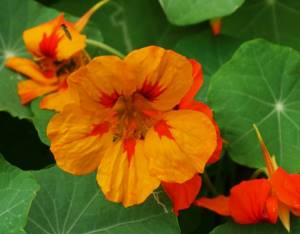
May nasturtium
- Silk Road
The climbing plant has a thick stem, from which lateral shoots extend in large numbers. Inflorescences of different colors are located on high peduncles.
- Cherry rose
The unusual coloring of the plant makes it popular among gardeners. The height of the bushes is up to 30 cm. The buds are painted in a rich red color.
- Black Lady (Black Velvet)
The plant is distinguished by burgundy buds with yellow spots. The bush can reach a height of more than 40 cm.
- Moonlight
The crop grows in the form of vines reaching a length of up to 3 meters. Small buds are light yellow in color.
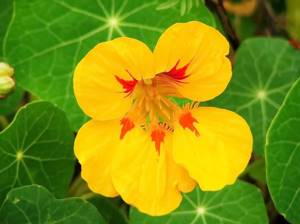
Variety Moonlight
- Golden Globe
The bush has the shape of a ball. Often used to create compositions.
The height of the bush can reach up to 40 cm. The leaves are large, shield-shaped. The buds are large, terry, golden in color.
- Gleming Mahagani
The bush is stable, the height can reach up to 40 cm. The inflorescences are densely located on the shoots. The bud is double, red.
- Ladybug
A compact plant, the height of which can reach up to 25 cm. The leaves are small, the branches are underdeveloped. A special feature of the buds is a delicate apricot color with dark spots.
- Salmon Baby
The liana can reach a length of up to 2 meters. Often used to decorate gazebos. Blooms in early summer, retains buds until the first frost. The flowers are salmon-colored.
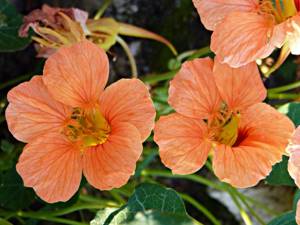
Variety Salmon Baby
- Peach Melba
Nasturtium is low growing. The height of the bushes can reach up to 30 cm. The shoots are weak and spread along the ground. The leaves are round in shape and rich green in color. The buds can be yellow and orange.
- King Theodore
The height of the bush reaches 40 cm. The leaves are small and green. A distinctive feature is the terry red buds.
Important! The flowers of the plant contain large amounts of vitamin C. Therefore, the buds are often eaten as additions to salads.
Planting in flowerpots, flowerpots and pots

White peonies - description and characteristics of the best varieties with a colored center
Nasturtium grown in pots
Nasturtium planted in a flowerpot has an unusual appearance and allows you to create hanging compositions.
All types of crops can be used for cultivation. However, the most attractive are the low-growing varieties that do not form long vines.
Planting the crop with seeds is carried out at the end of May. To grow seedlings, seeds must be planted in pots a month before planting. Seedlings should be planted in open ground after the air has warmed up and there is no risk of frost.
Nasturtiums on the balcony are most often planted in box pots. With the help of the plant you can create a bright flower bed on the balcony. For private homes, the ideal solution would be to plant seeds in flowerpots installed along garden paths.
Features of care in the garden and on the balcony
For balconies, terry mixture of nasturtium is most often used. The flowers have bright colors. Care in the garden and on the balcony is no different. In order for the plant to bloom profusely, the following points must be observed:
- It is necessary to water the bushes daily. It is recommended to spray the bushes with water from a spray bottle in the evening.
- Loosen the soil regularly, especially if the plant is grown on a windowsill.
- Remove weeds in a timely manner.
- It is also recommended to remove faded buds and dried branches.
In order for the nasturtium in the pot to bloom profusely, it is recommended to regularly apply nitrogen and potassium fertilizers. For these purposes, ready-made mixtures are used, which must be dissolved in water and the bushes must be fed once a week.
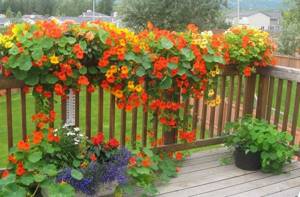
Growing on the balcony
When growing a plant in the garden, a problem often arises when shoots spread along the ground. It is important to know how to tie climbing nasturtium:
- Supports for bushes are installed as soon as the first shoots appear. It is necessary to stretch the wire between the supports.
- After young shoots appear, it is necessary to straighten the vine, forming a beautiful fan.
- To strengthen the vine, you should not use a rope, since the side shoots quickly intertwine with each other, forming a solid canvas.
Often, several plant varieties are used to form such vertical flower beds.
Attention! In order for the flowerbed to bloom profusely throughout the summer, it is recommended to install automatic watering systems.
When and how does it bloom
During the flowering period, the culture attracts everyone's attention. You need to know how nasturtium blooms and what care rules must be followed during the formation of buds.
Flowers consist of 5 or less than 6 petals. Flowers may be double, semi-double or simple. The size of the buds depends on the variety, and can range from 2 to 8 cm in width.
The shape of the flowers is irregular and looks like a hood. At the base of the flower there is a small spur-shaped growth. The original name of the flower was capuchin, which matches the description of the flower.

Flower shape
The period when nasturtium blooms is from mid-June to October. If the seeds are sown at the end of May, the flowering period occurs at the beginning of July.
To extend the flowering period, it is necessary to increase watering before the formation of buds. However, after the first flowers appear, watering stops and is carried out no more than once a week.
The liquid is applied using the root method, so that drops of water do not fall on the buds. It is also necessary to stop fertilizing.
Nasturtium care
Caring for nasturtium is relatively simple and not labor-intensive. As we have already mentioned, nasturtium is a light-loving crop, but it can easily grow and bloom in partial shade. They live best in loamy, well-drained soils. Under no circumstances should nasturtiums be fertilized with fresh organic fertilizers or lime applied. Excess nitrogen fertilizers and waterlogging of the soil are also contraindicated, which leads to excessive development of green parts and reduces the number and power of flower stalks. Lack of light causes weakening of the stems, which stretch, while the leaves become small and the plant looks stunted. In this regard, regular watering and fertilizing should be done only before flowering begins. After the flowers appear, watering should be done as the soil dries. Sometimes plants are placed near a pond and watering is generally reduced to a minimum.
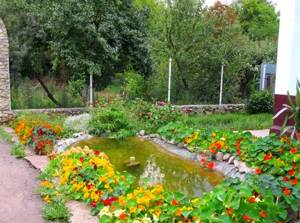
It is important to know that nasturtiums need fairly intensive watering only during development. At this time, you need to water the flowers every other day, and in hot weather every day, preferably in the evening when it cools down. Never water in sunny weather. Drops of water on the leaves have the property of lenses, which leads to overheating of the surface of the leaves and the flowers themselves. Therefore, in gardens equipped with a drip irrigation system, watering should be done only in the evening.
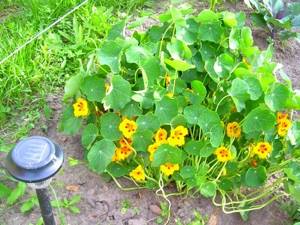
To preserve the nutritional properties of the soil near the plants, reached by their roots, and the freedom of the roots, it is advisable to do weeding by removing weeds. This is especially true for weeds with a powerful root system, such as wheatgrass. To avoid the proliferation of these weeds, before planting nasturtiums, the soil must be dug to a depth of at least 25 cm and all weed roots must be removed. It is quite possible to get rid of other weeds by mulching.
To prolong the flowering of nasturtium, wilted and dried stems should be periodically removed. In the fall, to collect seeds, it is enough to leave only a few of the most powerful stems, and it is better to remove the rest.
Possible problems in growing
If not cared for correctly, many gardeners wonder why the plant does not bloom. Such symptoms can appear for several reasons.
Pests
Thanks to its bright aroma, the plant is often used in the country to repel pests. However, in rare cases, parasites such as caterpillars may appear on the nasturtium itself. To combat them, it is necessary to pollinate the bushes with wood ash.
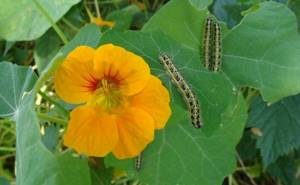
Pests of nasturtium
Diseases
Nasturtium has high immunity to diseases. However, in some cases the following problems may occur:
- bacterial wilt;
- spotting;
- gray rot.
When the first signs of the disease appear, the affected area is carefully trimmed.
Important! To prevent the plant from being exposed to diseases, it is necessary to soak the seeds in a light solution of manganese before planting.
Signs of improper care
If not properly cared for, the plant may not form inflorescences. The following factors may be the reasons:
- Use large amounts of water for irrigation. It is necessary to water the plant in small quantities so that the soil is moistened superficially. The accumulation of water leads to the appearance of rot in the root system.
- Use of fertilizers in large quantities. This is especially true for nitrogen-containing substances. Nitrogen provokes the appearance of green mass, but inflorescences will not form. Therefore, it is recommended to alternate different substances during feeding.
- Planting a plant in the shade. Nasturtium prefers sunny places, so planting near buildings and in the shade of trees is not recommended.
Caring for and growing crops in open ground is not difficult if you follow the recommendations of experienced gardeners.
Growing
If you are interested in nasturtiums and want to have them on your plot, even if you have experience in growing other flowers, you should still familiarize yourself with the peculiarities of growing these flowers.
To begin with, you should decide on the type of plants and, depending on this, choose the place where to plant them. Keep in mind that nasturtiums are quite heat-loving plants, and at the same time they do not tolerate the sun. That is, the place for them should be sufficiently lit and without drafts. This may well be an area located along the walls of a house or along a continuous fence, if it is not shaded by tall trees.
In terms of soil, nasturtiums are quite unpretentious, planting is done in a standard way, but still too fertilized soil, especially with organic fertilizers, will not benefit them, since in this case their green parts will mainly grow, to the detriment of flowering. The lack of sunlight will also have a negative effect, the stems will stretch out, the leaves will be small and the plant will only lose its decorative properties.
If you decide to place nasturtiums in a flowerbed, then it is advisable that it be protected on at least two sides by taller plants or shrubs that prevent drafts.
If you prefer to decorate the facade of a house or a gazebo with hanging nasturtiums, then it is also better to place baskets, boxes or flowerpots not on walls exposed to the wind, but in places where individual structures of the house adjoin, for example a terrace, which will also protect them from drafts.
Nasturtiums look very original and fresh, expressed as a separate type in pots, containers, baskets and of course in flowerpots, which give the color a special charm of antiquity.
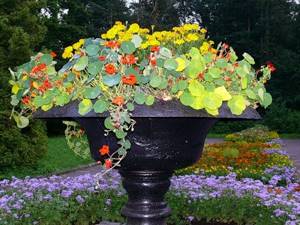
Nasturtium, like all annuals, reproduces by seeds, which is why it is most convenient to grow it from seeds. There are two ways. The first is sowing seeds directly into open ground, the second is growing seedlings with subsequent transplanting.
The first method makes it possible for the plant to grow strong, which will not get sick and will continue to bloom for a long time. But due to the fact that we often have spring with changeable weather, even frosts are frequent, seeds have to be sown in open ground at the end of May, when the soil has already warmed up. To sow seeds, you need to prepare a place for sowing; for bush nasturtium, it is optimal to use a ribbon or a flowerbed. In this case, it is necessary to provide drainage, this is due to the peculiarity of the root system. Sowing should be done when the outside air temperature does not fall below +8 degrees Celsius. The holes should be placed at a distance of 25-30 centimeters from each other. Plant the seeds to a depth of no more than 2-3 centimeters. It is better to plant 3-4 seeds in one hole.
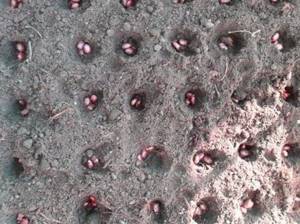
Nasturtium sown with seeds should be watered after two to three days. Shoots will appear in two weeks.
Nasturtiums sown in this way in warm weather and optimal watering will bloom within a month and a half after germination.
The second option is to grow seedlings and then transplant them into open ground. In this case, seedlings sown with seeds in containers or pots germinate and develop at home or in a warm room for about a month or a little more. And then the already sufficiently developed plant is transferred to open ground. Typically, seedlings are sown at the end of April, at the beginning of May, then by the onset of warm weather the plants will be ready for transplanting into open ground and quite quickly, already in the first half of June, they will begin to bloom.
To do this, take a container for growing, it is better if it is a special cassette for seedlings. They come with a translucent cover. You need to choose ones with cells 8-10 centimeters deep. Place drainage at the bottom of the cells; expanded clay is most often used for this. Then fill in the prepared soil; it should be moderately fertile, and with a slightly acidic environment. 3-4 seeds are sown in each cell of the cassette to a depth of 2-3 cm. It is better to install the cassette in a well-lit place but not in direct sunlight, so that it does not warm up excessively. Watering should be carried out constantly, keeping the soil moist but not wet. In two weeks the shoots will appear.
It is more convenient to grow nasturtium seedlings in peat pots, because they can be transplanted into open ground along with the pots without damaging the root system.
It is necessary to continue growing in a cassette or in pots until the outside air temperature is stable, even at night, + 8-10 degrees. After this, the strengthened plants can be planted in open ground. Replanting must be done with a lump of soil, trying not to expose the roots when replanting. If you did everything correctly, then after two or three you will be able to see the first flowers.

Nasturtium seeds of any variety are now freely available in stores. But if you wish, you can collect them yourself from already faded plants. After the leaves on the plant fall off, about a month later, the seeds can be collected. After collection, they need to be dried and can be stored for quite a long time.
Germination persists for almost 4 years. When sowing seeds, you need to keep in mind that if the seeds have been stored for more than a year, then before sowing they need to be kept in hot water + 40-45 degrees for half an hour, and then left in warm water for a day. In this way their germination improves.
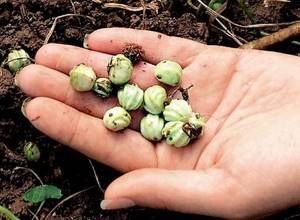
Experienced flower growers use another way to propagate especially rare varieties of nasturtium, especially double ones, this is cuttings. To do this, the plant is grown in a portable container, pot or flowerpot, which is removed indoors for the winter. They are usually placed in bright, cool conditions and kept with limited watering. With this regime, in a semi-dormant state, nasturtium survives well until spring. In the spring, the fleshiest shoots are cut into cuttings and placed in damp sand, where they produce roots. After this, the rooted cuttings are transplanted into the ground and plants are grown that fully retain the properties of the mother in shape and color.
Use in landscape design

Using nasturtium in landscape design
Nasturtium is used to decorate garden plots. It can be planted as an independent plant or as a landscape composition.
Nasturtium is often used to decorate gazebos and airy flower beds. The composition of different varieties of nasturtium against a background of greenery also looks attractive.
Nasturtium is divided into a large number of varieties and subspecies. It can be grown not only in the garden, but also on the balcony. The culture pleases with lush flowering throughout the summer. The plant also has a large number of beneficial properties and can even be eaten fresh.
